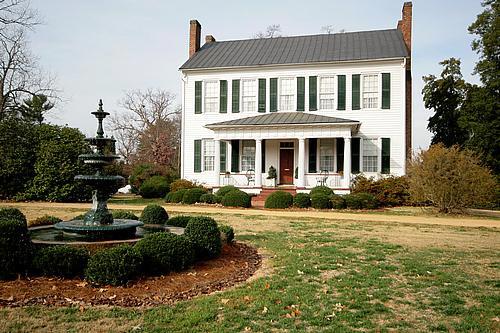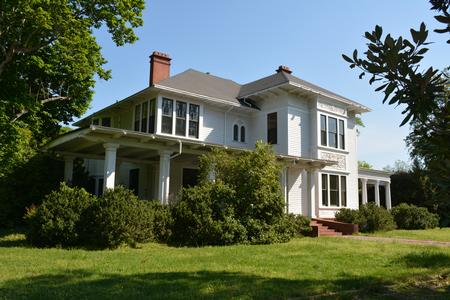From The Archives
c. 1830 Greek Revival
Mooresville, North Carolina 28115
Mount Mourne Plantation


Main foyer with hardwood floors and Grand Staircase

Front and rear parlors can be separated by large folding doors

Dining Room with one of the 10 fireplaces. Over head lighting fixture is controlled by a bell pull near the door to the Library.

Library just off the Dining Room, was probably the original Plantation Office.

One of the four stately bedrooms on the upper floor

Upper Landing with stairs continuing to the full Attic.

Modern Bathroom with jetted tub and large Sitting Room

Remodeled Kitchen with Gas Range and other updated appliances.

Old Smokehouse sits on a portion of the 3.65 estate
| 2 Stories | |
| Bedrooms | 4 |
| Full Baths | 1 |
| Heated Sq. Ft. | 4,160 |
| Acres | 3.7 |
Features.
- 1st Floor Bath
- Basement
- Dining room
- Foyer
- Laundry Room
- Library
- Walk-Up Attic
- Master bedroom upstairs
- Circular driveway
- Gazebo
- Porch
- Built-in Bookcases
- Fireplaces
- High Ceilings
- Jacuzzi
- Original wood windows
- Wood floors
- Central air
- City sewer
- City water supply
- Dishwasher
- Disposal
- Gas heating
- Range
- Refrigerator
- Water Heater - Gas
No Contact Information.
This listing is archived and is not for sale.
Contact information is not available for archived listings.
Experince Old Charlotte History at Mount Mourne Plantation
This handsome restored Federal-Greek Revival manor house was built circa 1830 for Rufus Reid, a successful merchant and planter. While there are no supporting historic documents, it appears to be the work of Jacob Stirewalt, master North Carolina Piedmont builder.The exterior architecture is distinguished by the handsome portico that features full entablature that supported by solid, fluted Doric columns, four Flemish bond chimneys and a high stone foundation. All framing, joists, and rafters are pegged rather than nailed and the beams are hand hewn. Ceilings are 14 feet in heights on the first floor and 13 feet on the second level. Windows, doors, and rafters are marked with Roman numerals and it appears that the exterior walls are all filled with noggin. The heart-pine flooring is original, as is the plaster through-out the house (however, in restoration, the original plaster over the mantels on the first & second floors was built out.) The windows of the main block are 9 over 9 with many original panes. The windows of the facade and south elevation are flanked by cedar shutters (architectural copies of the one original shutter that survived kindling usage of former tenants.) The exterior doors and door originally leading to the basement still use the original keys. The front and back hall locks are carpenter locks (English locks). The hall basement door lock has a wooden housing.
A three pane transom tops the front entry door.
The two parlors become one by opening the center wall of six doors separating these two lovely and gracious rooms. The doors are joined by hinges covered decoratively with brass plates that are called butterfly hinges. These two rooms contain Federal mantels and solid slab granite hearths. The portrait over the front parlor mantel is of Rufus Reid. It is a copy of the original now in the possession of a descendant in New Jersey.
The spacious dining room contains an oversized Federal mantel with a granite hearth. This is a beautiful room for entertaining and connects to the present day library where you'll find the first Greek Revival mantel flanking yet another granite hearth. The bookcase is an addition and the base of it disguises the return air for the noth elevation furnace. This room was originally most likely Rufus Reid's office and an entry from the outside kitchen to the dining room.
The present-day kitchen is truly lovely and a cook's dream! (It has been constructed from a pantry or closet that was added to the house when it was "remodeled" about 1855 and again probably in the 1940's for a bathroom that was shared by tenants of three apartments for which the house was used during WWII.)The kitchen has been completely updated recently to tastefully feature solid surface countertops, recessed lighting, a enormous amount of cabinets, a gas cook-top with solid top cooking surface, undercounter lighting, wainscoting, dishwasher, refrigerator, double convection oven, and vegetable sink. This is truly an attractive room that is a cook’s joy and overlooks the back of the beautifully landscaped estate where there are nut and fruit trees of all shapes and descriptions. The kitchen connects to the back verandah which is an outside room that invites one and all to visit its rocking chairs and old-fashioned porch swing.
The back porch has been enclosed on both sides. The southern side originally had a breezeway (as a firebreak) from the “new kitchen” that was built about 1855. This room is now the dressing room and part of the very plush and elaborate and lovely bathroom of the home. This area consist of a walk-in tiled shower for two with three spray shower jets, a oversized air-jet tub, a gas burning fire place for a cozy room while bathing, and built-in cabinets and closets galore. There’s also double sinks with solid surface counter-tops and the rooms is well lighted with recessed lighting.
The second level of living in this home is reached by way of the center stairway that presents a cantilevered Federal stair of walnut that features Jacob Stirewalt’s signature tulip bracket design (a feature from Owen Biddle’s YOUNG CARPENTER’S ASSISTANT). The upstairs hall contains the closets that are referred to in Reid’s papers in SOUTHERN HISTORICAL COLLECTION, Chapel Hill, NC. Notes there say that the closets contained linens and they listed the lines used for every day use and those used for guest. The closets are reputed to be made of cypress which has the same properties a cedar regarding insect control. There are four large bedrooms on this second story level that each have heart pine flooring, 13 foot ceilings, working fireplaces and Greek Revival mantels. The stairs and landing leading to the attic are here on the second floor also. The left wall to the attic has never been painted and reveals the workmanship of the plaster. Some of the children through the generations have written their names and dates there. The attic is floored with 10” pine boards. Gables ascend from sides of the attic to center without benefit of collar beam construction for support.
The Basement has been dug out to standing height with a ledge around a stone foundation. Granite piers support the inner part of the house. The center support is brick. A log partition separates the basement into sections. An ell was added at some point and the use of the two lower rooms ( one an office and the other a workshop came into being). There have been many theories as to their former uses, ie: summer dining, warming kitchen, laundry room, cook’s quarters.
The second level of living in this home is reached by way of the center stairway that presents a cantilevered Federal stair of walnut that features Jacob Stirewalt’s signature tulip bracket design (a feature from Owen Biddle’s YOUNG CARPENTER’S ASSISTANT). The upstairs hall contains the closets that are referred to in Reid’s papers in SOUTHERN HISTORICAL COLLECTION, Chapel Hill, NC. Notes there say that the closets contained linens and they listed the lines used for every day use and those used for guest. The closets are reputed to be made of cypress which has the same properties a cedar regarding insect control. There are four large bedrooms on this second story level that each have heart pine flooring, 13 foot ceilings, working fireplaces and Greek Revival mantels. The stairs and landing leading to the attic are here on the second floor also. The left wall to the attic has never been painted and reveals the workmanship of the plaster. Some of the children through the generations have written their names and dates there. The attic is floored with 10” pine boards. Gables ascend from sides of the attic to center without benefit of collar beam construction for support.
The Basement has been dug out to standing height with a ledge around a stone foundation. Granite piers support the inner part of the house. The center support is brick. A log partition separates the basement into sections. An ell was added at some point and the use of the two lower rooms ( one an office and the other a workshop came into being). There have been many theories as to their former uses, ie: summer dining, warming kitchen, laundry room, cook’s quarters.
Archived in November, 2012
Comments & Feedback
All information deemed reliable but not guaranteed and should be independently verified. All properties are subject to prior sale, change or withdrawal. OldHouses.com is not responsible for any typographical errors, misinformation, misprints and shall be held totally harmless.

 OldHouses.com headquarters, Union, SC.
OldHouses.com headquarters, Union, SC.








